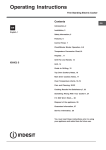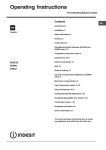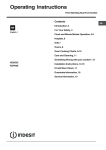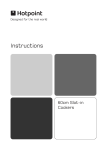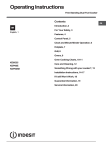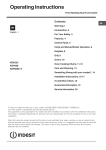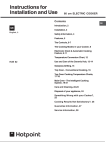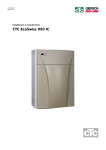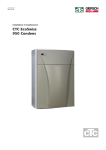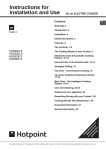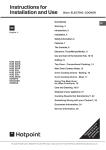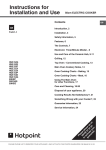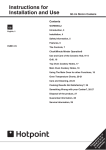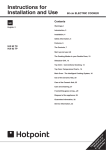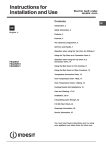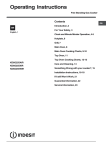Download Indesit ID60C2K S
Transcript
Operating Instructions Free Standing Electric Cooker Contents GB Introduction, 2 Installation, 3 English, 1 Safety Information, 4 Features, 6 Control Panel, 7 Clock/Minute Minder Operation, 8-9 Temperature Conversion Chart, 10 Ceramic Hob, 11-12 Grill, 13 ID60C2 S ID60C2 AA Guide to Grilling, 14 Top Oven Cookery Notes , 15 Main Oven Cookery Notes, 16 Oven Temperature charts, 17-18 Care and Cleaning, 19-20 Cooking Results Not Satisfactory?, 21 Something Wrong With Your Cooker?, 22 If it Still Won't Work..., 23 Disposal of the appliance, 23 Guarantee Information, 24 Service Information, 25 You must read these instructions prior to using your appliance and retain them for future use. GB Introduction GB Your new appliance is guaranteed* and will give lasting service.This guarantee is only applicable if the appliance has been installed in accordance with the installation instructions detailed in this booklet. To help make best use of your cooking equipment, please read this booklet carefully. The cooker is designed specifically for domestic use and responsibility will not be accepted for use in any other installation. When the cooker is first used an odour may be emitted, this will cease after a period of use. When first using the cooker ensure that the room is well ventilated (e.g. open a window or use an extractor fan) and that persons who may be sensitive to the odour avoid any fumes. It is suggested that any pets be removed from the room until the smell has ceased. This odour is due to temporary finish on oven liners and elements and also any moisture absorbed by the insulation. * The guarantee is subject to the provisions that the appliance: (a) Has been used solely in accordance with the Users Instruction Book. (b) Has been properly connected to a suitable supply voltage as stated on the rating plate attached to this equipment. (c) Has not been subjected to misuse or accident or been modified or repaired by any person other than the authorised employee or agent. (d) Has been correctly installed. Technical Characteristics Top Oven Usable Volume: 42 Litres ENERGY LABEL and ECODESIGN Regulation (EU) No 65/2014 supplementing Directive 2010/30/EU. Regulation (EU) No 66/2014 implementing Directive 2009/125/EC. Standard EN 60350-1 Standard EN 50564. Declared energy consumption for Natural convection Class heating mode: Conventional Main Oven Usable Volume: 74 Litres ENERGY LABEL and ECODESIGN Regulation (EU) No 65/2014 supplementing Directive 2010/30/EU. Regulation (EU) No 66/2014 implementing Directive 2009/125/EC. Standard EN 60350-1 Standard EN 50564. Declared energy consumption for Forced convection Class heating mode: Fan Oven Voltage and Frequency 230-240V~ 50Hz Hob ECODESIGN Regulation (EU) No 66/2014 implementing Directive 2009/125/EC. Standard EN 60350-2. Standard EN 50564. This appliance conforms with the following European Economic Community directives: - 2 EC of 12/12/06 (Low Voltage) and 2006/95/EC subsequent modifications; EC of 15/12/04 (Electromagnetic 2004/108/EC Compatibility) and subsequent modifications; EC 2002/96/EC 1275/2008 (Stand-by/ Off mode) Radio Interference This appliance conforms to EN 55014 regarding suppression of radio and television interference. Installation WARNING - THIS APPLIANCE MUST BE EARTHED. Mains Connection Your cooker should have been checked to ensure that the voltage corresponds with your supply voltage, this is stated on the rating plate, which is situated on the outer rear panel.The model number and the serial number are located on the front of the cooker, as shown on the Features page. The cooker must be connected by a competent person such as one who is a, NICEIC registered contractor to a suitable double-pole control unit with a minimum rating of 32A and a minimum contact clearance of 3mm (applicable to newer properties, older properties where a 30A double pole control unit and a minimum contact clearance of 3mm is acceptable). The double pole control unit should be fitted adjacent to the cooker, in accordance with IEE regulations.The control unit must be within 2 metres of but not directly above the appliance and should be easily accessible in the event of an emergency. The power supply cable should conform to B.S.6004 with a conductor size of 6mm2, minimum. Access to the mains terminals is gained by removing the rear access cover. The mains cable must pass through the cable clamp adjacent to the terminal block. Sufficient cable should be used to allow the cooker to be pulled out for servicing. Ensure that the mains cable is routed away from any brackets affixed to the rear panel and is not trapped to the rear wall when pushing the cooker into position between cabinets. For the installation of the feeding cable carry out the following operations: 1 Open the terminal board by inserting a screwdriver into the bottom tabs of the cover. Use the screwdriver as a lever by pushing it down to open the cover (see diagram). 2 Loosen the cable clamp screw and remove it, using a screwdriver as a lever (see figure). 3. Fasten the wires under the screw heads, respecting the colour code: Black/Blue (N), Red/Brown (L) and Bare Wire/YellowGreen ( ). Once the connections have been made, tighten all the terminal screws fully. Fasten the supply cable in place with the clamp and close the cover of the terminal board. Levelling Four feet are fitted which can be adjusted up or down to set the height (900mm - 930mm) and level the cooker. The feet can be simply screwed in or out to lower or raise the cooker. After the correct height is achieved, lock the feet into position by tightening the locking nut using an open ended spanner. CAUTION: Some soft floor coverings may get damaged if the cooker is not moved carefully. NOTE: Ensure oven shelves are level by using a spirit level on the rod shelves. Siting the Cooker The cooker is designed to fit between kitchen cabinets spaced 600mm apart. The space either side need only be sufficient to allow withdrawal of the cooker for servicing and cleaning. It can be used with cabinets one side or both as well as in an angled corner setting. It can also be used freestanding. Adjacent side walls which project above hob level, must not be nearer to the cooker than 150mm and should be protected by heat resistant material. Any overhanging surface or cooker hood should not be nearer than 650mm. Note: This appliance must NOT be fitted on a platform. Moving the Cooker Before moving your cooker, switch off at the cooker control unit, ensure that it is cool. Open the grill door sufficiently to allow a comfortable grip on the underside front edge of the oven roof, avoiding any grill elements. Note: Take care in moving the cooker as it is heavy.Take care to ensure that any floor covering is not damaged. 3 GB Safety Information WARNING: The appliance and its accessible parts become hot during use. The internal surfaces of the compartment (where present) may become hot. Care should be taken to avoid touching heating elements. Children less than 8 years of age shall be kept away unless continuously supervised. Never use steam cleaners or pressure cleaners on the appliance. Remove any liquid from the lid before opening it. This appliance can be used by children aged from 8 years and above and persons with reduced physical, sensory or mental capabilities or lack of experience and knowledge if they have been given supervision or instruction concerning use of the appliance in a safe way and understand the hazards involved. Children shall not play with the appliance. Cleaning and user maintenance shall not be made by children without supervision. Do not close the glass cover (if present) when the gas burners or electric hotplates are still hot. WARNING: Unattended cooking on a hob with fat or oil can be dangerous and may result in fire. NEVER try to extinguish a fire with water, but switch off the appliance and then cover flame e.g. with a lid or a fire blanket. ! When you place the rack inside, make sure that the stop is directed upwards and in the back of the cavity. ! VERY HOT SURFACES FOOD OR GREASE ON THESE SURFACES COULD CAUSE SMOKE AND POSSIBLY EVEN BURN YOU MUST KEEP THE OVEN AND GRILL CAVITIES CLEAN ! ATTENTION DURING INSTALLATION THE FEET OF THE APPLIANCE MUST BE LOWERED SO THAT AN AIR GAP OF AT LEAST 10MM (1CM) IS LEFT BETWEEN THE BASE OF THE APPLIANCE AND THE FLOOR. WARNING: Danger of fire: do not store items on the cooking surfaces. WARNING: If the surface in glassceramic is cracked, switch off the appliance to avoid the possibility of electric shock. Do not use harsh abrasive cleaners or sharp metal scrapers to clean the oven door glass since they can scratch the surface, which may result in shattering of the glass. 4 10 mm GB ! ATTENTION WHEN USING THE MAIN OVEN YOU MUST ENSURE THAT THE BASE OF THE CAVITY IS NOT COVERED WITH ALUMINUM FOIL, UTENSIL OR ANY OTHER FORM OF COVERING. FAILURE TO DO THIS MAY RESULT IN THE CAVITY BEING DAMAGED. Safety Information When used properly your appliance is completely safe but as with any electrical product there are certain precautions that must be observed. PLEASE READ THE PRECAUTIONS BELOW BEFORE USING YOUR APPLIANCE. Always • • • • • • • • • • • • • • • • • • Remove all packing from the appliance before switching on for the first time. Understand the controls prior to using the appliance. Keep children away from the appliance when cooking as the surfaces will get extremely hot during and after use. Turn controls off when not in use. Stand back when opening an oven door to allow any build up of steam or heat to disperse. Always use dry good quality oven gloves when removing items from the oven/grill. Always place pans centrally over the hotplate making sure handles are kept away from the edge of the hob and cannot become heated by other hotplates or pans. Always take care to avoid heat or steam burns when operating the controls. Always turn off the electricity supply at the wall switch and allow the appliance to cool before cleaning (or changing an oven lamp if fitted). Always make sure the shelves are in the correct position before switching on the oven or grill. Always keep the oven/grill door closed when the appliance is not in use. Always keep the appliance clean as a build up of grease or fat from cooking can cause a fire. Always follow the basic principles of food handling and hygiene to prevent the possibility of bacterial growth. Always keep ventilation slots clear of obstructions. Always refer servicing to a qualified appliance service engineer. Always take care when removing items from the grill compartment when the lower oven is in use as the contents will be hot Always turn off the electricity supply to the appliance at the wall switch should any glass panel (if fitted) crack or shatter and then DO NOT USE THE APPLIANCE until repaired. During use, the oven becomes hot. Care should be taken to avoid touching heating elements inside the oven. !The appliance must be used by adults only for the preparation of food, in accordance with the instructions outlined in this booklet. Any other use of the appliance (e.g. for heating the room) constitutes improper use and is dangerous. The manufacturer may not be held liable for any damage resulting from improper, incorrect and unreasonable use of the appliance. Never • • • • • • • • • • • • • • • • Never stare at Halogen heating units Never leave children unsupervised where a cooking appliance is installed as all surfaces will be hot during and after its use. Never allow anyone to sit or stand on any part of the appliance. Never store items above the appliance that children may attempt to reach. Never leave anything on the hob surface when unattended and not in use. Never remove the oven shelves whilst the oven is hot. Never heat up unopened food containers as pressure can build up causing the container to burst. Never store chemicals/food stuffs or pressurised containers in or on the appliance, or in cabinets immediately above or next to the appliance. Never place flammable or plastic items on or near the hob. Never fill a deep fat frying pan more than 1/3 full of oil. Never use a lid. DO NOT LEAVE DEEP FAT FRYING PANS UNATTENDED WHILE COOKING. Never use the appliance as a room heater. Never use the grill to warm plates. Never dry any items on either the hob or oven doors. Never install the appliance next to curtains or other soft furnishings. Never operate the grill with the grill door closed as this will cause the appliance to over heat. Never use 'steam cleaners'. SAFETY ADVICE IN CASE OF A CHIP-PAN FIRE In the event of a chip pan fire or any other pan fire. 1. TURN OFF THE COOKER APPLIANCE AT THE WALL SWITCH. 2. COVER THE PAN WITH A FIRE BLANKET OR DAMP CLOTH, this will smother the flames and extinguish the fire. 3. LEAVE THE PAN TO COOL FOR AT LEAST 60 MINUTES BEFORE MOVING IT. Injuries are often caused by picking up a hot pan and rushing outside with it. NEVER USE A FIRE EXTINGUISHER TO PUT OUT A PAN FIRE as the force of the extinguisher is likely to tip the pan over. Never use water to extinguish oil or fat fires. ! The appliance should not be operated by people (including children) with reduced physical, sensory or mental capacities, by inexperienced individuals or by anyone who is not familiar with the product. These individuals should, at the very least, be supervised by someone who assumes responsibility for their safety or receive preliminary instructions relating to the operation of the appliance. 5 GB Features GB 1200W Ceramic 1800W Ceramic 1800W Ceramic 1200W Ceramic Clock/Minute Minder Control panel Model number and Serial number label Conventional Grill Grill pan food support Grill pan with fixed/detachable handle Top oven/grill rod shelf Top oven wirework shelf supports Main oven wirework shelf supports Fan blade Main oven rod shelves Inner glass panel 6 Control Panel GB Main oven neon Hob hot neon Top oven neon Clock / Minute Minder Main oven Top oven Grill Operating controls when the grill is in use In common with all cookers having controls sited above the grill compartment, care must be taken when setting the controls, due to the hot air expelled from the grill compartment. Note: After use, it is advisable to check that all cooker controls have been switched Off. Cooling fan A gentle flow of air will be blown below the control panel when the grill is in use.When the oven/s are in use the cooling fan will operate after a short period of time and may run on, after all controls are switched off. Left Front Left Rear Right Rear Right Front Oven light The oven light will illuminate when the main oven thermostat is operated. The light will remain on during the cook period. Hob Hot Neon A short time (approx. 30 seconds) after the hob heating areas have been turned on, the Hob Hot neon will illuminate. This light will remain illuminated until all the hob controls have been turned off and all hob heating areas have cooled. 7 Clock and Minute Minder CLOCK OPERATION GB To Set Time of Day 00.00 12.00 Step 1 Check that the electricity supply to the cooker is turned on. Step 2 When switched on the display will show 0.00 flashing intermittently. Step 3 Press the " " button and then press either the "+" or "-" buttons to set the correct time of day. Note: If the electricity supply has been off, the "+" button must be pressed once before the "-" button, if it is required to reduce the time of day. THE TIME OF DAY IS NOW SET. 8 Clock and Minute Minder 00.20 MINUTE MINDER OPERATION GB To Set the Minute Minder Step 1 Press the "+" button until the required time is set. A "Bell" symbol will light up. During setting the time adjusts in 10 second intervals up to a maximum of 99mins 50secs. It can also be adjusted by pressing the "-" button. At the end of the set time, a bleeping sound will be heard and the "Bell" will disappear. 1 3.23 The bleeper can be cancelled by pressing the "+" button. BLEEPER SOUND To adjust the pitch of the bleeper, press the "-" button while the bleeper is sounding. For example:(a) Press the "+" button and set 10 seconds. (b) When the bleeper sounds, press and release the "" button, until preferred pitch is set. (c) Press and release the "+" button to cancel the bleeper. NOTE: If the sound of the bleeper appears to be different, it is most likely that the pitch of the bleeper has been inadvertently adjusted. 9 Temperature Conversion Chart Condensation GB °F Main Conventional Oven Main Fan Oven ½ 250 120 100 1 275 140 120 2 300 150 130 3 325 160 140 4 350 180 160 5 375 190 170 6 400 200 180 7 425 220 200 8 450 - 210 9 475 - 220 Gas Mark Temperatures The recommended temperatures given are for conventional and fan ovens. When using a fan oven it will be necessary to reduce the cooking time by 10 minutes per hour and lower the temperature by up to 20°C. Also, in the majority of cases, it is not necessary to pre-heat the oven. However, pre-heating is recommended when cooking items such as Yorkshire puddings, whisked sponges and bread. Your experience with the cooker will enable you to select the cooking time and temperature best suited for your recipe. 10 Condensation may become evident on the inner door and water may drip through the vent. This is normal when heat and moisture are present and may be a result of any of the following: 1. Kitchen temperature and ventilation. 2. The moisture content of the food eg. meat, roast potatoes, Yorkshire pudding, roasting meat, etc. 3. The quantity of the food being cooked at any one time. Ceramic Hob WARNING: DO NOT USE THE HOB IF IT IS CRACKED. TO AVOID ELECTRIC SHOCK - SWITCH OFF AT THE COOKER MAINS CONTROL SWITCH IMMEDIATELY AND CONTACT YOUR NEAREST SERVICE OFFICE (see KEY CONTACTS, back page). GB R ating s of C o okin g Zon es Mo del Fro nt L eft F ro nt R igh t B ack Left B ack R igh t ID 60 C 2 C eramic 1800W C eramic 1200W C eramic 1200W C eramic 1800W The Working of the Heating Zones Heating only occurs within the marked circular cooking zones. The zones heat up and cool down quicker, providing greater controllability for sensitive foods. Each heating zone is equipped with a thermal limiter which is a safety cut-out which prevents the ceramic glass from overheating. After several minutes at full power without a pan on the heating zone the thermal limiter will switch the heating elements off and on automatically to avoid any damage to the ceramic glass. Choice of saucepan's It is essential that the saucepan's you use on the ceramic hob are suitable. Do Not In order to keep your ceramic hob in good condition, follow these simple guidelines: Do Do not not Do not Do not Do not ALWAYS USE: • • • • Do not Good quality pans with smooth, flat, heavy bases. saucepan's manufactured from aluminium (enamelled or machined) or stainless steel. Correct size saucepan's. The base of the pan must cover the heating zone completely. saucepan's with lids which are well fitting to reduce cooking time and energy use. Do not Do not Do not NEVER USE: • • • • Do not Pans with thin, distorted or uneven bases as these will extend cooking times, waste electricity and cause damaging, local hotspots on the glass surface. Pans with ridged or recessed bases. Pans with damaged or rough bases which could scratch the glass surface. Glass or glass ceramic utensils. Do not stare at halogen heating units. cook directly on the hob surface without a cooking utensil, as this will result in damage to the surface of the hob. use the hob as a worktop surface as damage may occur to the smooth surface of the hob. drag or slide utensils on the hob surface, as this will cause scratches in the surface of the hob. allow a cooking utensil to come into contact with the hob surround. place anything between the base of the utensil and the ceramic hob, e.g. do not use asbestos mats, aluminium or wok stand. leave any utensils, food or combustible items on the hob when it is not in use. place aluminium or plastic foil, or plastic containers on the hob. leave the hotplates or cooking areas switched On unless they are being used. leave heating zones uncovered when they are switched On. We recommend not to place large preserving pans or fish kettles across two heating areas. leave utensils partly covering the heated areas. Always ensure that they are placed centrally over the heated areas and have the same diameter as the heating area used. 11 Care of the Ceramic Hob GB Do A l w a y s ensure that the bottom of the pan is both clean and dry. Dirt or moisture between the pan and the hob can cause pitting of the surface of the glass. We do not recommend the use of utensils with a base diameter greater than 25cm (l0ins). Pressure cookers or other large pans should be used on the front cooking areas. A l w a y s ensure that saucepan handles are positioned safely. A l w a y s take extra care when cooking foods with a high sugar content eg. jam, as spillage will cause damage to the surface of the glass. A l w a y s clean spills immediately (see Care and Cleaning). IMPORTANT - As with any cooking appliance there could be some fire risk attached to the heating of oil, particularly for deep fat frying, cooking utensils containing oil must not be left unattended (e.g. to answer the telephone) on or in close proximity to the patterned cooking areas. 1. Use a deep pan, large enough to completely cover the appropriate heating area. 2. Never fill the pan more than one-third full with fat or oil. 3. Never leave oil or fat unattended during the 12 heating or cooking period. 4. Do not try to fry too much food at a time, especially frozen food. This only lowers the temperature of the oil or fat too much, resulting in greasy food. 5. Always dry food thoroughly before frying, and lower it slowly into the hot oil or fat. Frozen foods, in particular, will cause frothing and spitting, if added too quickly. 6. Never heat fat, or fry, with a lid on the pan. 7. Keep the outside of the pan clean and free from streaks of oil or fat. 8. Never allow excessive splashing of oil onto the hob. Safety requirements for deep fat frying In the unfortunate event of a chip pan fire: 1. Switch Off the electricity supply. NEVER attempt to move the pan - burns and injuries are caused almost invariably by picking up the burning pan and rushing outside with it. 2. Smother flames with a fire blanket or damp cloth. NEVER use a fire extinguisher to put out a pan fire, as the force of the extinguisher is likely to tip the pan over. NEVER use water to extinguish oil or fat fires. When smothering the flames DO ENSURE that you FACE and ARMS are WELL PROTECTED from the flames to save you from becoming hurt. 3. After the fire has been extinguished LEAVE THE PAN TO COOL FOR AT LEAST 60 MINUTES BEFORE MOVING IT. 4. If you fail to put the fire out, call the fire brigade immediately. Grill Setting the Grill GB Door in grilling position CAUTION - ACCESSIBLE PARTS MAY BECOME HOT WHEN THE GRILL IS IN USE. CHILDREN SHOULD BE KEPT AWAY. GRILLING SHOULD NEVER BE UNDERTAKEN WITH THE DOOR CLOSED. The grill control is designed to provide variable heat control of either the twin grill elements on together or the single left hand grill element only, depending upon which direction the control knob is rotated. - With the control rotated clockwise 1 through to 4 the twin elements will come on together. - With the control turned anti-clockwise 1 through to 4 and the single left hand element will come on only. The control is Off at O. Note :The grill will not operate unless the top oven control is in the OFF position. Food which requires browning only should be placed under the hot grill, directly on the shelf on the first or second position from the bottom of the oven, according to the depth of the dish. Open the Grill door to the grilling position. i.e. fully. With the grill door in the grilling position, heating the grill is achieved by turning the control clockwise to the desired 'grill setting' on the control panel. Never: line the grill pan with aluminium foil. Note: Preheat the grill at maximum setting for approximately 5 minutes. The grill pan is placed on the shelf or grill pan support/runner and should be correctly positioned under the grill element. Leave the control at maximum for toast, sealing and fast cooking of foods. For thicker foods requiring longer cooking, turn the switch to a lower setting after the initial sealing on both sides at maximum. The thicker the food the lower the control should be set. 13 Guide To Grilling GB Pre - heat the grill for 5 minutes on maximum control setting before grilling. GRILL CHART Food Grill Setting Approximate Cooking Time Toasting of Bread products 4 / Max 3 - 10 mins. Small cuts of meat, sausages, bacon, etc. 4 / Max for 4 mins. reduce to lower setting. 10 - 20 mins. Chops etc. Gammon steaks Chicken pieces 4 / Max for 6-8 mins. reduce to lower setting. 20 - 30 mins. 4 / Max 10 - 20 mins. Whole fish and fillets placed in the base of the grill pan. Fish in breadcrumbs 3/5 15 - 20 mins. Pre - Cooked potato products 3/5 15 - 20 mins. Pizzas 3/5 12 - 15 mins. in the base of the grill pan. Browning of food 4 / Max 8 - 10 mins.Dish placed directly on shelf. Fish: fingers Whole Fillets The settings in the above guide have been developed to cook food successfully without excessive fat spitting and splashing. 14 Top Oven Cookery Notes The top oven should be used to cook small quantities of food.The oven is designed so that the grill element operates at a reduced heat output, this is combined with a heating element situated underneath the floor of the oven. To ensure even cooking of the food it is important that cooking utensils are positioned correctly on the oven shelf so that the element is directly above. There are two cooking positions, the shelf placed on runner 1 or 2 (from the base), do not use shelves upside down. Food/utensils must not be placed directly on the oven floor. There should always be at least 25mm (1in) between the top of the food and the grill element. Warning: Items stored in top oven will get hot when main oven is in use. Operation To heat the oven, turn the control knob clockwise.The top oven pilot light will come on and remain on until the oven reaches the required temperature.The pilot light will automatically go on and off during cooking as the thermostat maintains the correct temperature. Cooking meat/poultry Small joints of meat up to 1.5kg (3 lbs), or poultry, up to 3.6kg (8 lbs) (60cm cookers) in weight can be roasted in a small meat pan in the top oven. Larger joints of meat/poultry weighing more than 3.6kg (8 lbs) (60cm cookers) should be roasted in the main oven. Do not use the grill pan as a meat pan in the top oven as air circulation will be seriously restricted. Top oven as a warming compartment for plates Place the plates/dishes on the shelf, positioned on runner 1, turn top oven control to 100°C for 10-15 minutes.Never use grill control. 15 GB Main Oven Cookery Notes GB The oven is fitted with wirework shelf supports and two rod shelves. To heat the oven turn the knob clockwise, selecting the require temperature between 80°C (176°F) and 230°C (450°F) as recommended in the temperature chart. The pilot light will immediately come on and remain on until the oven reaches the required temperature. This light will then automatically go off and on during cooking as the oven thermostat maintains the correct temperature. It should be noted that at the end of the cooking period there may be a momentary puff of steam when the oven door is opened. This will disperse in a few seconds and is a perfectly normal characteristic of an oven with a good door seal. Since a circulaire fan oven heats up more quickly,and generally cooks food at a lower temperature than a conventional oven, pre-heating is often unnecessary.However, foods such as bread, scones,Yorkshire pudding,do benefit from being placed in a pre-heated oven. The 'oven temperature charts' are a guide only, giving approximate cooking temperatures and times.To suit personal taste and requirements, it may be necessary to increase or decrease temperatures by 10°C. Unless otherwise indicated in the charts food should be placed in a cold oven, i.e. without pre-heating. If food is placed in an already hot oven, the suggested cooking time should be reduced, depending on the type and quantity of food being cooked. WARNING! The oven is provided with a stop system to extract the racks and prevent them from coming out of the oven.(1) As shown in the drawing, to extract them completely, simply lift the racks, holding them on the front part, and pull (2). 16 Oven positions Since the distribution of heat in the circulaire fan oven is very even, most foods will cook satisfactorily on any shelf position, but the shelves should be evenly spaced. The top oven rod shelf can be used in the main oven when cooking large quantities of food. Additional shelves can be purchased through your oven supplier or our Parts Department (see Key Contacts, back page). Food or utensils should Never be placed directly an the floor of the oven for cooking. Never use more than 3 shelves in the oven as air circulation will be seriously restricted.To ensure oven circulation do not use meat pans larger than 390 x 300mm (15"x12") and baking trays no larger than 330 x 255mm (13"x 10"), these should be positioned centrally on the oven shelf. Food should not be placed directly on the floor of the oven. To avoid unnecessary cleaning, rod shelves which are not in use, should be removed from the oven. Temperature and time When all three shelves are used to cook large quantities of food for home freezing or parties, it may be necessary to increase the cooking times given in the temperature charts by a few minutes, to allow for the loss of heat due to extra time taken to load the oven, and the larger mass of food. Baking trays should have an equal gap at either side of the oven. Frozen meat and poultry Joints of meat and whole birds should be defrosted slowly, preferably in a domestic refrigerator (allowing 5-6 hours per 450g (1 lb), or at room temperature (allowing 2-3 hours per 450g (1 lb). Oven Temperature Charts - Meat Top Oven Cooking (KD6C35 and KDP60 only) Meat Pre-heat Temperature °C Time (approx.) Beef/ Lamb (slow roasting) Yes 170/180 35 mins per 450g (1lb) + 35 mins over. Beef/ Lamb (foil covered) Yes 190/200 35-40 mins per 450g (1lb) Pork (slow roasting) Yes 170/180 40 mins per 450g (1lb) + 40 mins over Pork (foil covered) Yes 190/200 40 mins per 450g (1lb) Veal (slow roasting) Yes 170/180 40-45 mins per 450g (1lb) + 40 mins over Veal (foil covered) Yes 190/200 40-45 mins per 450g (1lb) Poultry/Game (slow roasting) Yes 170/180 25-30 mins per 450g (1lb) + 25 mins over Poultry/Game (foil covered) Yes 190/200 25-30 mins per 450g (1lb) Casserole Cooking Yes 150 2-2½ hrs Position in Oven Runner 1 from bottom of oven. If using aluminium foil, never: 1.Allow foil to touch sides of oven. 2.Cover oven interior with foil. 3.Cover shelves with foil. Fan Oven Cooking (all models) Meat Pre-heat Temperature °C Time (approx.) Beef No 160/180 20-25 mins per 450g (1lb) +25 mins extra Lamb No 160/180 25 mins per 450g (1lb) +25 mins extra Pork No 160/180 25 mins per 450g (1lb) +25 mins extra Veal No 160/170 25-30 mins per 450g (1lb) +25 mins extra Chicken / Turkey up to 4kg (8lb) No 160/180 18-20 mins per 450g (1lb) +20 mins over Turkey up to 5.5kg (12lb) No 150/160 13-15 mins per 450g (1lb) e.g. 5kg (11lb) = 143-165 mins Turkey over 5.5kg (12lb) No 150 12 mins per 450g (1lb) e.g. 10kg (22lb) = 264 mins Casserole Stews No 140-150 1½ - 2 hrs Position in Oven Runner 1 from bottom of oven. If using aluminium foil, never: 1.Allow foil to touch sides of oven. 2.Cover oven interior with foil. 3.Cover shelves with foil. The most accurate method of testing the readiness of joints of meat or whole poultry is to insert a meat thermometer into the thickest part of a joint, or the thickest part of poultry thighs, during the cooking period.The meat thermometer will indicate when the required internal temp has been reached. Beef Rare: 60°C Lamb: 80°C Poultry: 90°C Medium: 70°C Pork: 90°C Well Done: 75°C Veal: 75°C 17 GB Oven Temperature Charts - Baking GB Top Oven Cooking (KD6C35 and KDP60 only) Baking Pre-heat Temperature °C Time in mins. Position in Oven Scones Yes 210/220 10-15 Runner 2 from bottom of oven Small Cakes Yes 180/190 20-25 Runner 2 from bottom of oven Victoria Sandwich Yes 170/180 20-30 Runner 2 from bottom of oven Sponge Sandwich Yes 180/190 20-25 Runner 2 from bottom of oven Swiss Roll Yes 200/210 10-15 Runner 2 from bottom of oven Semi-rich Fruit cakes Yes 150/160 60-75 Rich Fruit Cakes Yes 140/150 Depending on size Runner 1 or 2 from bottom of oven Shortcrust Pastry Yes 190/200 Depending on size Runner 2 from bottom of oven Puff Pastry Yes 200/210 Depending on size Runner 2 from bottom of oven Yorkshire Pudding Yes 190/200 30-40 Runner 2 from bottom of oven Individual Yorkshire Pudding Yes 200/210 20-30 Runner 2 from bottom of oven Milk Pudding Yes 140/150 90-120 Runner 2 from bottom of oven Baked Custard Yes 150/160 40-50 Runner 2 from bottom of oven Bread Yes 200/210 30-45 Runner 1 from bottom of oven Meringues Yes 100 150-180 Runner 2 from bottom of oven 7 inch Runner 2 from bottom of oven Fan Oven Cooking (all models) Baking Pre-heat Temperature °C Time in mins. Position in Oven Scones Yes 210/220 8-10 Runner 2 from bottom of oven Small Cakes 170/180 15-20 Runner 2 from bottom of oven Victoria Sandwich 160/170 20-25 Runner 2 from bottom of oven Sponge Sandwich Yes 170/190 15-20 Runner 2 from bottom of oven Swiss Roll Yes 180/190 10-15 Runner 2 from bottom of oven Semi-rich Fruit cakes 140/150 60-75 Runner 2 from bottom of oven Rich Fruit Cakes 130/140 Depending on size Runner 1 or 2 from bottom of oven Shortcrust Pastry 190/200 45-50 Runner 2 from bottom of oven Puff Pastry 190/200 Depending on use Runner 2 from bottom of oven Yorkshire Pudding Yes 180/190 40-45 Runner 2 from bottom of oven Individual Yorkshire Pudding Yes 190/200 20-25 Runner 2 from bottom of oven Milk Pudding 130/140 105-135 Runner 2 from bottom of oven Baked Custard 140/150 40-50 Runner 2 from bottom of oven 200/210 40-50 Runner 1 from bottom of oven 80-90 180-240 Runner 2 from bottom of oven Bread Meringues Yes Note: If soft margarine is used for cake making, temperatures recommended by the manufacturers should be followed.Temperatures recommended in this chart refer to cakes made with block margarines or butter only. 18 Care and Cleaning TURN OFF THE MAIN SWITCH AND ENSURE THE COOKER IS COLD BEFORE CLEANING. BEFORE SWITCHING ON AGAIN, ENSURE THAT ALL CONTROLS ARE IN THE OFF POSITION. NEVER USE BIOLOGICAL WASHING POWDER, HARSH ABRASIVES, SCOURING PADS, AEROSOL CLEANERS OR OVEN CHEMICAL CLEANERS OF ANY KIND, UNLESS SPECIFIED BELOW. ! Never use steam cleaners or pressure cleaners on the appliance. ! Clean the glass part of the oven door using a sponge and a non-abrasive cleaning product, then dry thoroughly with a soft cloth. Do not use rough abrasive material or sharp metal scrapers as these could scratch the surface and cause the glass to crack. ! The accessories can be washed like averyday crockery (even in your dishwasher). Cleaning materials to avoid: 1. Plastic or nylon pads 2. Household abrasive powders and scourers.These may scratch the surface. 3. Oven chemical cleaners, aerosols and oven pads. Caustic cleaners such as these will etch the surface and attack the metal frame. 4. Bath and sink cleaners may mark the surface. ALWAYS SWITCH OFF AT THE MAINS SWITCH BEFORE CLEANING. Ceramic hotplates: Clean your Ceramic hob top regularly and avoid repeated burning of encrusted contamination. Your choice of cleaner will depend on the degree of soiling involved (see below). minor soiling, where the contamination has not burnt hard, can be wiped off with a clean wet cloth • major soiling and strongly-adhering burnt encrustation can be quickly and easily removed with a razor-blade scraper • hard water stains, grease spots and discolouration having a metallic sheen can be removed with 'Easy Do Cleaner Powder' • always condition hob after cleaning by using 'Easy Do Conditioner' or 'Hob Brite'. Apply a small amount of conditioner with a clean damp cloth or paper towel. Rub vigorously. Remove excess with a clean damp cloth or paper towel. Polish with a clean cloth or paper towel before the conditioner dries. Detergent residues must always be completely • removed with a clean wet cloth, (even if the instructions for use suggest otherwise), as they can have an etching effect when reheated. Then wipe dry. To maintain hob in good condition, we would recommend regular use of the 'Easy Do Powder Cleanser'. Sprinkle Powder Cleanser on a clean damp cloth or paper towel and rub vigorously for 3 to 4 minutes. Remove all residue with a clean damp cloth or paper towel.Then use conditioner to protect the hob. For more stubborn marks, mix a small amount of the powder cleanser with 'Jif Lemon Juice' (from a bottle) and carefully spread over the affected area. Cover with a damp paper towel and leave for a minimum of 15 minutes.Rub vigorously. Remove excess with a clean damp cloth or paper towel before the conditioner dries. Polish with a clean cloth or paper towel. Easy Do products are available from many electrical retailers, our Parts Department (see Key Contacts, back page) and our Spares Distributors. Homecare 'Hob Brite' is available from leading Supermarkets. Oven shelf supports The shelf supports are removable and dishwasher safe. To remove hold the support at the front and pull away from the oven side, this can then be cleaned in a sink or a dishwasher. When removed it allows access to the oven side, which can be cleaned with warm soapy water. To refit the support, insert the longer leg into the rear fixing hole and push in the front leg. Decorative trims It is advisable to clean the decorative trims regularly to prevent any build up of soiling which may detract from the appearance of the cooker.The recommended method of cleaning is to wipe over the trims with a soft cloth wrung out in warm water or mild non-abrasive cleaner. (If in doubt try the cleaner on a small area of trim which is not noticeable in normal use).Then, after wiping with a cloth wrung out in clear water, dry with a soft clean cloth. Never use scouring pads or abrasive cleaners/ powders which may scratch the surface. Take care during cleaning not to damage or distort the door seals.Do not lift the door seal from the oven chassis, if necessary remove the seal by carefully unhooking the corner clips. Take care that the rating label edges are not lifted during cleaning, and furthermore that the lettering is not blurred or removed. 19 GB Care and Cleaning Control Panel: Wipe with a damp cloth and polish with a dry cloth. GB Stainless trims Regularly wipe with a clean, damp cloth and polish with a clean dry cloth. Grill Door: Wipe over the grill door decorative outer panel; with a cloth wrung out in warm soapy water, then after wiping with a cloth wrung out in clear water, dry with a soft clean cloth. Do not use scouring pads or abrasive powder which may scratch the surface. Ensure that the glass panel (where fitted) is not subjected to any sharp mechanical blows. Grill: Remove the grill pan and the wire grid food support, it is best to wash these items immediately after each use to prevent stains from being burnt on when used again. Wipe out the Grill compartment, use a fine steel wool soap pad to remove stubborn stains from the compartment. Main oven: 1. Glass Door - open the oven door fully.The glass panel may now be cleaned. Stubborn stains can be removed by using a fine steel wool soap pad.Do not use scouring pads, or abrasive powder, which will scratch the glass. Ensure that the glass panel is not subjected to any sharp mechanical blows. For slight soiling the inner glass panel may be cleaned, while still warm. For removing stubborn stains see “Care and Cleaning” chapter. 2. Remove the rod shelves and meat pan. Use a fine steel wool soap pad to remove stubborn stains from the rod shelves,meat pan and the floor of the oven. Refer to the instructions in “Care and Cleaning” chapter, for cleaning the shelf supports. Do not use aerosol cleaners on this oven as they could adversely affect the fan motor unit, and cannot be wiped off the fan blade. Replacement oven lamp: WARNING: To avoid electric shocks - please ensure that the electricity supply to the appliance is switched off and the appliance is fully cold, before removing the lamp lens. Open the oven door and remove the rod shelves. Using a suitable cloth to protect the fingers grip the light glass dome, unscrew anti-clockwise and lift. Reach into the aperture and unscrew the lamp anticlockwise. Fit replacement lamp (25W 300°C rated SES), refit dome. 20 Wall-mounted splash panel: A wall-mounted splash panel is available as an optional extra from our Parts Department (see Key Contacts, back page). Care must be taken that rating label edges are not lifted during cleaning and furthermore that the lettering is not blurred or removed. For details of your nearest Service Centre please see the separate service leaflet. If you have any queries regarding service or spares, our Parts and Service Division will be pleased to advise. See Key Contacts, back page, for details. Take particular care not to damage the inner surface of the door inner glass that is coated with a heat reflective layer.Do not use scouring pads, or abrasive powder, which will scratch the glass. Ensure that the glass panel is not subjected to any sharp mechanical blows. Stubborn stains can be removed by using a fine steel wool pad. For slight soiling the inner glass panel may be cleaned, while still warm, without removing it from the door. After cleaning, rinse and dry with a soft cloth. CLEANING THE DOORS SIDE OPENING DOORS Cleaning the door glass is the same as the drop down doors,except take care to support the weight of the inner glass when removing and refitting. DROP DOWN DOORS Remove the door inner glass as follows. 1. Open the door fully and unscrew the two screws securing the glass panel so that the securing brackets can be turned.There is no need to remove the screws completely. 2. Turn the brackets so that the glass can be removed and cleaned at the sink (Fig. 1.) 3. The inside of the outer door glass can now be cleaned while still fitted to the cooker. NEVER OPERATE THE COOKER WITHOUT THE INNER DOOR GLASS IN POSITION. Refit the door inner glass as follows. 1.Turn the two securing brackets back to their original position to retain the glass and tighten the screws. (Fig. 2.) Cooking Results Not Satisfactory? Problem Check Grilling U neven cooking front to b ack E nsure th at the g rill p an is p ositioned ce ntrally b elow the g rill element. Fat splattering E nsure th at the g rill is not set to too hig h a setting. Baking (G eneral) U neven rising of cakes E nsure th at the oven shelves are level by using a spirit level on the rod shelf and a djusting the w heels/feet. The o ven should b e che cked both left to rig ht and front to b ack. S inking of cakes S inking o f cakes The follow ing may ca use cakes to sink: 1. P reheating of fan ovens. 2. C ooking at too high a temperature. 3.U sin g normal cre amin g method w ith soft margarine. (u se the all-in-one method ). 4. If using soft margarine use th e all-in -one method Over/U nd er cooking Fast/S low cooking R efer to the cookin g times and temp eratures g iven in the oven temperature charts, how ever, it may b e necessary to increa se or d ecrease temperatures b y 10°C to suit personal taste. D o not use utensils greater tha n 56 mm (2¼in s) in heig ht. U neven cooking of cakes 1. Too large ba king sheet use d. (S ee 'C ookery N otes', for corre ct sizes). 2. Over load ing of oven and alw ays ensure even air g aps around baking tins. 3. P laced into pre-heated oven. (S ee oven temp erature charts) Top O ven Baking: U neven cooking front to b ack E nsure th e coo king utensil is positioned centrally und er the g rill element. U neven rising of cakes E nsure th at the shelf is level (see above) and tha t the foo d is p ositioned c entrally in the oven. Overcooking R ememb er to red uce cooking te mpera tu res b y 10°C from stand ard recipes w hen using the top oven. Food is taking too lon g to cook E nsure th at the cooking utensil used in the top oven is not larg er than 300x225mm (12ins x 9ins). Only cook on e item at a time to avo id overloading the oven. GB 21 Something Wrong with your Cooker? GB Before contacting your nearest Service Centre/ Installer, check the problem guide below; there may be nothing wrong with your cooker. Problem Slight odour or small amount of smoke when grill / oven used for first time This is normal and should cease after a short period. Nothing works If you find that the timer display is blank, then it is likely that there is no electricity supply to your oven. Check: (i) That the main cooker wall is switched on (ii) Other appliances, to see if you have had a power cut (iii) The main circuit breaker for the property Grill / Top Oven do not work. Main oven works (a) Grilling with the door closed - Always grill with the door fully open (b) Grilling for an excessively long period at maximum setting - see Grilling guide. Switch off appliance and allow to cool for approx 30 mins. Switch the cooker back on and check that the Grill / Top oven (as applicable) is now operating. Oven temperatures too high or low Check temperature and shelf positions are as recommended in the Oven Temperature Charts. It may be necessary to increase or decrease the recommended temperature slightly to suit your taste. Oven lamp does not work The oven lamp is not covered by the guarantee. The part is easily changed (see the section on oven lamp replacement). A new lamp may be obtained from our Parts department, see Key Contacts, back page. Grill does not work Ensure that the top oven control is turned fully off. Grill keeps turning on and off When the Grill control is operating at less than its maximum setting, the Grill will cycle on and off, this is normal and not a fault. Draught from beneath control panel A gentle flow of air will be blown from beneath the control panel when the appliance is used. If the appliance is still warm, this cooling fan may run on, or restart itself when all controls have been turned off. The fan will stop once the appliance has been cooled.This is normal and not a fault. Condensation on the wall at the rear of the cooker Steam and / or condensation may appear from the vent at the rear of the appliance when using an oven particularly for foods with a high water content e.g. frozen chips, roast chicken etc.This is normal, and any excess should be wiped off. Steam / Condensation in the oven after use Steam is a by - product of cooking any food with a high water contact. To help minimise always: a) Try to avoid leaving food in the oven to cool after being cooked. b) Use a covered container, wherever possible. 22 If it Still Won't Work Contact the Service Office If something is still wrong with your appliance after you have been through the 'Something Wrong' list: 1. Switch off and unplug the appliance from the mains. 2. Call your nearest Service Office or local importer. When you contact us we will want to know the following: 1. Your name, address and postcode. 2. Your telephone number. 3. Clear and concise details of the fault. 4. The Model number and the Serial number of your appliance. 5. The date of purchase (please keep the receipt as evidence will be required when an engineer calls) enter the date here: ............................................................................. Please make sure you have all these details ready when you call. Spare Parts Please remember your new appliance is a complex piece of equipment. 'DIY' repairs or unqualified and untrained service people may put you in danger, could damage the appliance and might mean you lose cover under the Parts Guarantee. If you do experience a problem with the appliance don't take risks, call in our Service Engineer. Our Parts are designed exclusively to fit your appliance. Do not use them for any other purpose as you may create a safety hazard. Disposal of your product To minimise the risk of injury to children please dispose of your product carefully and safely. Remove all doors and lids. Remove the mains cable (where fitted) by cutting off flush with the appliance and always ensure that no plug is left in a condition where it could be connected to the electricity supply. To help the environment, Local Authority instructions should be followed for the disposal of your product. collected separately in order to optimise the recovery and recycling of the materials they contain and reduce the impact on human health and the environment. The crossed out "wheeled bin" symbol on the product reminds you of your obligation, that when you dispose of the appliance it must be separately collected. Consumers should contact their local authority or retailer for information concerning the correct disposal of their old appliance. Respecting and conserving the environment • Whenever possible, avoid pre-heating the oven and always try to fill it. Open the oven door as little as possible because heat is lost every time it is opened. To save a substantial amount of energy, simply switch off the oven 5 to 10 minutes before the end of your planned cooking time and use the heat the oven continues to generate. • Keep gaskets clean and tidy to prevent any door energy losses • If you have a timed tariff electricity contract, the “delay cooking” option will make it easier to save money by moving operation to cheaper time periods. • Make the most of your hot plate's residual heat by switching off cast iron hot plates 10 minutes before the end of your cooking time and glass ceramic hot plates 5 minutes before the end of cooking time. • The base of your pot or pan should cover the hot plate. If it is smaller, precious energy will be wasted and pots that boil over leave encrusted remains that can be difficult to remove. • Cook your food in closed pots or pans with well-fitting lids and use as little water as possible. Cooking with the lid off will greatly increase energy consumption • Use purely flat pots and pans • If you are cooking something that takes a long time, it's worth using a pressure cooker, which is twice as fast and saves a third of the energy. Disposal of old electrical appliances The European Directive 2002/96/EC on Waste Electrical and Electronic Equipment (WEEE), requires that old household electrical appliances must not be disposed of in the normal unsorted municipal waste stream. Old appliances must be 23 GB Guarantee GB 12 months Parts and Labour Guarantee Your appliance has the benefit of our manufacturer's guarantee, which covers the cost of breakdown repairs for twelve months from the date of purchase. This gives you the reassurance that if, within that time, your appliance is proven to be defective because of either workmanship or materials, we will, at our discretion, either repair or replace the appliance at no cost to you. The guarantee is subject to the following conditions: - The appliance has been installed and operated correctly and in accordance with our operating and maintenance instructions. - The appliance is only used on the electricity or gas supply printed on the rating plate. - The appliance has been used for normal domestic purposes only. - The appliance has not been altered, serviced, maintained, dismantled or otherwise interfered with by any person not authorised by us. - Any repair work must be undertaken by us or our appointed agent. - Any parts removed during repair work or any appliance that is replaced become our property. - The appliance is used in the United Kingdom or Republic of Ireland. The guarantee does not cover: - Damage resulting from transportation, improper use, neglect or interference or as a result of improper installation. - Replacement of any consumable item or accessory. These include but are not limited to: plugs, cables, batteries, light bulbs, fluorescent tubes and starters, covers and filters. - Replacement of any removable parts made of glass or plastic. THE GUARANTEE WILL NOT APPLY IF THE APPLIANCE HAS BEEN USED IN COMMERCIAL OR NON-DOMESTIC PREMISES. 5 Year Parts Guarantee Cannon also offers you a FREE 5 year parts guarantee. This additional guarantee is conditional on you registering your appliance with us and the parts being fitted by one of our authorised engineers. There will be a charge for our engineer's time. To activate the extra parts warranty on your appliance, simply call our registration line on 08448 24 24 24 (ROI 01 230 0800) Extended Guarantees We offer a selection of protection plans that enable you to fully cover yourself against the expense of repair bills for the life of your policy. To find the ideal plan for you please call our advice line on 08448 226 226 (ROI 01 230 0233) Free Helpdesk Service We have a dedicated team who can provide free advice and assistance with your appliance if you experience any technical difficulties within the first 90 days of ownership. Simply call our Indesit Service Hotline on 08448 224 224 (ROI 0818 313 413) for telephone assistance, or, where necessary, to arrange for an engineer to call. 24 After Sales Service GB No one is better placed to care for your Indesit appliance during the course of its working life than us - the manufacturer. Essential Contact Information Indesit Service We are the largest service team in the country offering you access to 400 skilled telephone advisors and 1100 fully qualified engineers on call to ensure you receive fast, reliable, local service. UK: 08448 224 224 Republic of Ireland: 0818 313 413 www.indesitservice.co.uk Please note: Our advisors will require the following information: Model number Serial number Parts & Accessories We supply a full range of genuine replacement parts as well as accessory products that protect and hygienically clean your appliance to keep it looking good and functioning efficiently throughout its life. UK: 08448 225 225 Republic of Ireland: 0818 313 413 www.indesitservice.co.uk Appliance Registration We want to give you additional benefits of Indesit ownership. To activate your FREE 5 year parts guarantee you must register your appliance with us. UK: 08448 24 24 24 Republic of Ireland: 01 230 0800 www.indesitservice.co.uk As part of Indesit's continued commitment to helping the environment, Indesit reserves the right to use quality, recycled components to keep down customer costs and minimise material wastage. Indesit Company UK Limited, Morley Way, Peterborough, PE2 9JB Indesit Company, Unit 49 Airways Industrial Estate, Dublin 17 25 Notes GB 26 Notes GB 27 04/2014 - 195122093.00 XEROX FABRIANO GB Indesit Company S.P.A. Viale Aristide Merloni,47 60044 Fabriano (AN) www.indesit.com 28




























